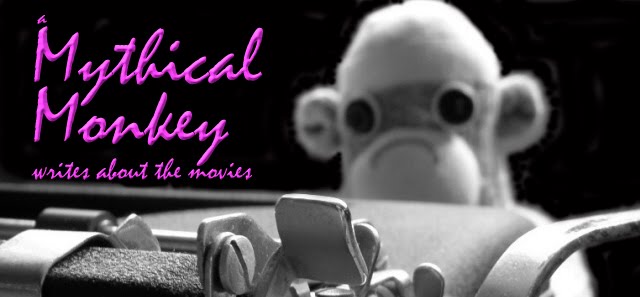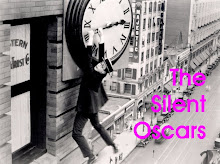 Director and film historian Peter Bogdanovich has called 1928 the greatest year in the history of movies, which is definitely saying something. If we expand the time frame a bit to include both 1927 and 1928, I will agree that he's on to something.
Director and film historian Peter Bogdanovich has called 1928 the greatest year in the history of movies, which is definitely saying something. If we expand the time frame a bit to include both 1927 and 1928, I will agree that he's on to something.Between January 1, 1927 and the end of 1928, more than a dozen films were released which might reasonably make a list of the best movies ever made, including The General, Metropolis, Napoleon (released too early in 1927 to qualify for this year's Katies), Sunrise: A Song Of Two Humans, The Crowd, The Man Who Laughs, The Student Prince In Old Heidelberg, The Circus, Wings; Laugh, Clown, Laugh and a handful of late 1928 releases, The Passion Of Joan Of Arc, The Wind, The Cameraman, Steamboat Bill, Jr., The Docks Of New York and The Wedding March (eligible for next year's Katies). Greta Garbo was never more popular, Gloria Swanson was still doing great work, Emil Jannings hadn't joined the Nazi party. Lon Chaney, Mary Pickford and Lillian Gish gave the best performances of their careers. Directors Murnau, Chaplin, Keaton, Lang and Dreyer were at or near their peaks, and Lubitsch was emerging as the next great director. Movie audiences wouldn't see such an outpouring of quality again until 1939, the year most film historians fix as the best ever, and it's clear, at least in retrospect, that silent movies had reached their highest ever level of artistic achievement and were poised for even greater breakthroughs.
 And yet, once The Jazz Singer hit theaters, studios couldn't pay audiences to see anything but talkies. Silent movies were better than ever but for the audiences of the time, they might as well have never been made. It's as if the "Mona Lisa" were hanging in Louvre unseen while art lovers rushed past it to crowd around a McDonald's placemat.
And yet, once The Jazz Singer hit theaters, studios couldn't pay audiences to see anything but talkies. Silent movies were better than ever but for the audiences of the time, they might as well have never been made. It's as if the "Mona Lisa" were hanging in Louvre unseen while art lovers rushed past it to crowd around a McDonald's placemat.There wouldn't again be such a disconnect between quality and box office receipts until the present age.
Commercially speaking—in the long run, the only language Hollywood speaks—silent movies were dead and there was no going back.
 Unfortunately, the new sound technology was primitive, relying on large, immobile cameras and unreliable microphones that glued actors in place and returned movies to that place from whence they had just escaped, the stage-bound theater. It took about five years for sound technology to become workable enough for directors to move the camera again and more than a decade for Orson Welles and cinematographer Gregg Toland to remember that they could.
Unfortunately, the new sound technology was primitive, relying on large, immobile cameras and unreliable microphones that glued actors in place and returned movies to that place from whence they had just escaped, the stage-bound theater. It took about five years for sound technology to become workable enough for directors to move the camera again and more than a decade for Orson Welles and cinematographer Gregg Toland to remember that they could.In the meantime, in case you need reminding, this is my list of movies that I consider the must-see movies of 1927-28. Unlike my list of Twenty Silent Movies To Cut Your Teeth On, not all of these movies are equally accessible to a viewer unfamiliar with silent movies, but I do believe every one of them is worth the time and effort is you are so inclined.
The Circus—Charlie Chaplin's comedy of a tramp who finds love and work in the circus
The Crowd—King Vidor's gritty tale of the American Dream turned nightmare
Laugh, Clown, Laugh—Lon Chaney as a man destroyed by love
The Man Who Laughs—a macabre love story about a man with a face that inspired Heath Ledger's Joker
The Student Prince In Old Heidelberg—a bittersweet romantic comedy about a prince who falls for a commoner
Sunrise: A Song Of Two Humans—my pick for the best movie of the year, about a marriage in crisis
Wings—a rip-snorting war picture about World War I flying aces and the girl they left behind
All but two of these movies, The Student Prince In Old Heidelberg and Wings, are available on DVD.
 You might also check out Sadie Thompson, the 1928 Gloria Swanson-Lionel Barrymore movie based on Somerset Maugham's short story "Rain." Time hasn't been kind to the print and the last reel has been lost, but film historians reconstructed the ending with the use of still photographs and what remains is very good. Sadie Thompson earned Swanson an Oscar nomination, the first of three, and might have earned her and Barrymore (the latter in a supporting role) Katies for their work if I could have been more certain of what I was seeing. Sadie Thompson is available on DVD.
You might also check out Sadie Thompson, the 1928 Gloria Swanson-Lionel Barrymore movie based on Somerset Maugham's short story "Rain." Time hasn't been kind to the print and the last reel has been lost, but film historians reconstructed the ending with the use of still photographs and what remains is very good. Sadie Thompson earned Swanson an Oscar nomination, the first of three, and might have earned her and Barrymore (the latter in a supporting role) Katies for their work if I could have been more certain of what I was seeing. Sadie Thompson is available on DVD.What can I tell you? This whole business of handing out awards, even with eighty years of hindsight, is a frustratingly subjective business. It only gets worse the closer to the present we get.






2 comments:
you're awfully lucky that I took 1927-1928 off in pursuit of major cooze.
Otherwise I'd be pissed. . . .
On the other hand, you were quite busy in 1928-29. Check back for my next round of Katie nominations on Monday or Tuesday ...
Post a Comment